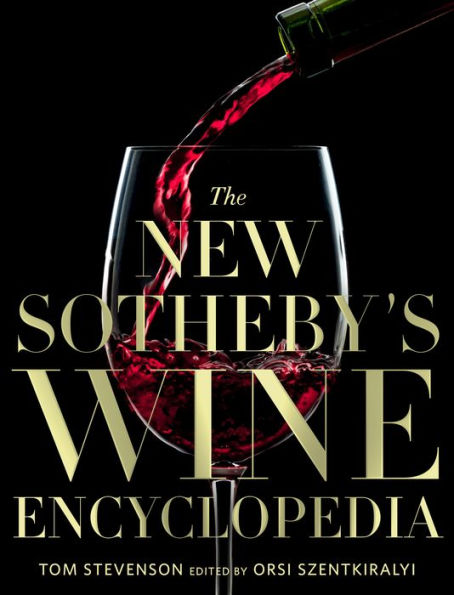The New Sotheby's Wine Encyclopedia
This essential reference for oenophiles — long used as the go-to text for the prestigious Master Sommelier examination — is the most comprehensive guide to the world of wine, featuring authoritative information on the history, culture, geography, and taste of vintages around the globe.
Fully updated and revised for the first time since 2011, this new 800-page edition of Sotheby's Wine Encyclopedia reflects the most recent trends in the dynamic world of wine, written by experts around the globe. Beautifully illustrated with more than 400 images and 100 brand-new National Geographic maps, this definitive guide is arranged geographically to highlight the regions and climates that produce the best vintages. From the countries of Southeast Europe to the Eastern Mediterranean, each page is packed with information on flavor notes, vineyard profiles, tasting room guides, grape know-how, and special information on unique varietals. The book also features top wines organized by maker and year; a troubleshooter's guide to potential wine faults; a taste chart to help identify flavors; up-and-coming producers; unusual wines, food pairings, and more. You'll find time lines depicting the chronology of wine from 500 million B.C., expert sommelier tips, and thousands of recommendations for the latest and greatest reds, whites, and rosés. The most up-to-date and comprehensive wine refence in the world, this stunning book is an oenophile's dream—and a must-have for anyone looking to become an expert in wine.
"1101056680"
Fully updated and revised for the first time since 2011, this new 800-page edition of Sotheby's Wine Encyclopedia reflects the most recent trends in the dynamic world of wine, written by experts around the globe. Beautifully illustrated with more than 400 images and 100 brand-new National Geographic maps, this definitive guide is arranged geographically to highlight the regions and climates that produce the best vintages. From the countries of Southeast Europe to the Eastern Mediterranean, each page is packed with information on flavor notes, vineyard profiles, tasting room guides, grape know-how, and special information on unique varietals. The book also features top wines organized by maker and year; a troubleshooter's guide to potential wine faults; a taste chart to help identify flavors; up-and-coming producers; unusual wines, food pairings, and more. You'll find time lines depicting the chronology of wine from 500 million B.C., expert sommelier tips, and thousands of recommendations for the latest and greatest reds, whites, and rosés. The most up-to-date and comprehensive wine refence in the world, this stunning book is an oenophile's dream—and a must-have for anyone looking to become an expert in wine.
The New Sotheby's Wine Encyclopedia
This essential reference for oenophiles — long used as the go-to text for the prestigious Master Sommelier examination — is the most comprehensive guide to the world of wine, featuring authoritative information on the history, culture, geography, and taste of vintages around the globe.
Fully updated and revised for the first time since 2011, this new 800-page edition of Sotheby's Wine Encyclopedia reflects the most recent trends in the dynamic world of wine, written by experts around the globe. Beautifully illustrated with more than 400 images and 100 brand-new National Geographic maps, this definitive guide is arranged geographically to highlight the regions and climates that produce the best vintages. From the countries of Southeast Europe to the Eastern Mediterranean, each page is packed with information on flavor notes, vineyard profiles, tasting room guides, grape know-how, and special information on unique varietals. The book also features top wines organized by maker and year; a troubleshooter's guide to potential wine faults; a taste chart to help identify flavors; up-and-coming producers; unusual wines, food pairings, and more. You'll find time lines depicting the chronology of wine from 500 million B.C., expert sommelier tips, and thousands of recommendations for the latest and greatest reds, whites, and rosés. The most up-to-date and comprehensive wine refence in the world, this stunning book is an oenophile's dream—and a must-have for anyone looking to become an expert in wine.
Fully updated and revised for the first time since 2011, this new 800-page edition of Sotheby's Wine Encyclopedia reflects the most recent trends in the dynamic world of wine, written by experts around the globe. Beautifully illustrated with more than 400 images and 100 brand-new National Geographic maps, this definitive guide is arranged geographically to highlight the regions and climates that produce the best vintages. From the countries of Southeast Europe to the Eastern Mediterranean, each page is packed with information on flavor notes, vineyard profiles, tasting room guides, grape know-how, and special information on unique varietals. The book also features top wines organized by maker and year; a troubleshooter's guide to potential wine faults; a taste chart to help identify flavors; up-and-coming producers; unusual wines, food pairings, and more. You'll find time lines depicting the chronology of wine from 500 million B.C., expert sommelier tips, and thousands of recommendations for the latest and greatest reds, whites, and rosés. The most up-to-date and comprehensive wine refence in the world, this stunning book is an oenophile's dream—and a must-have for anyone looking to become an expert in wine.
75.0
In Stock
5
1

The New Sotheby's Wine Encyclopedia
800
The New Sotheby's Wine Encyclopedia
800Hardcover
$75.00
75.0
In Stock

Product Details
| ISBN-13: | 9781426221415 |
|---|---|
| Publisher: | Disney Publishing Group |
| Publication date: | 10/27/2020 |
| Pages: | 800 |
| Sales rank: | 142,190 |
| Product dimensions: | 12.10(w) x 9.60(h) x 1.70(d) |
About the Author
From the B&N Reads Blog
